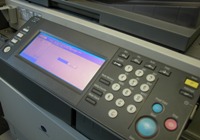Cutting paper usage

Photocopier
14 December 2007
Friday 14 December 2007
University strives to cut paper consumption
New public printing equipment has been installed by Aberystwyth University (AU) to reduce paper wastage and provide an improved service for students.
The new printers, which also work as photocopiers, are expected to reduce annual paper consumption by half a million sheets, a saving of at least 20%.
Installed in the University's public work rooms and libraries, the new printers are capable of printing on both sides of A3 and A4 paper, and ten offer both colour and black-and-white output.
In a further development designed to benefit the environment, only recycled paper will be used in these new machines.
The work has been overseen by Jeremy Perkins and Kerr Gardiner of Aberystwyth University's Information Services. Jeremy Perkins said:
“During the 2006/7 academic year approximately 2.5 million sheets of paper were used by staff and students using public printers. The new system is expected to reduce this to around 2 million by applying three simple steps:
• A document will only be printed when a person is ready to collect it from the printer. This means that there is no need for a “banner” page to identify the owner.
• As all of the new machines allow printing on both sides of the paper, the duplex setting will become the standard. It will still be possible to print on one side but a specific request will need to be made.
• Under the previous system a surprising number of documents were printed but never collected. Hopefully, if someone has taken the trouble to go to the printer and request output it will be because they do really want it.”
“We have also taken the decision to use recycled paper in all of these printers as quality paper from this source is now available at a comparable price to the new paper we were previously purchasing,” he added.
The new printers also save electricity as they automatically switch off after a set time of inactivity. Information Services are monitoring the best compromise between this feature and the inconvenience users experience on waiting for the device to warm up again.



